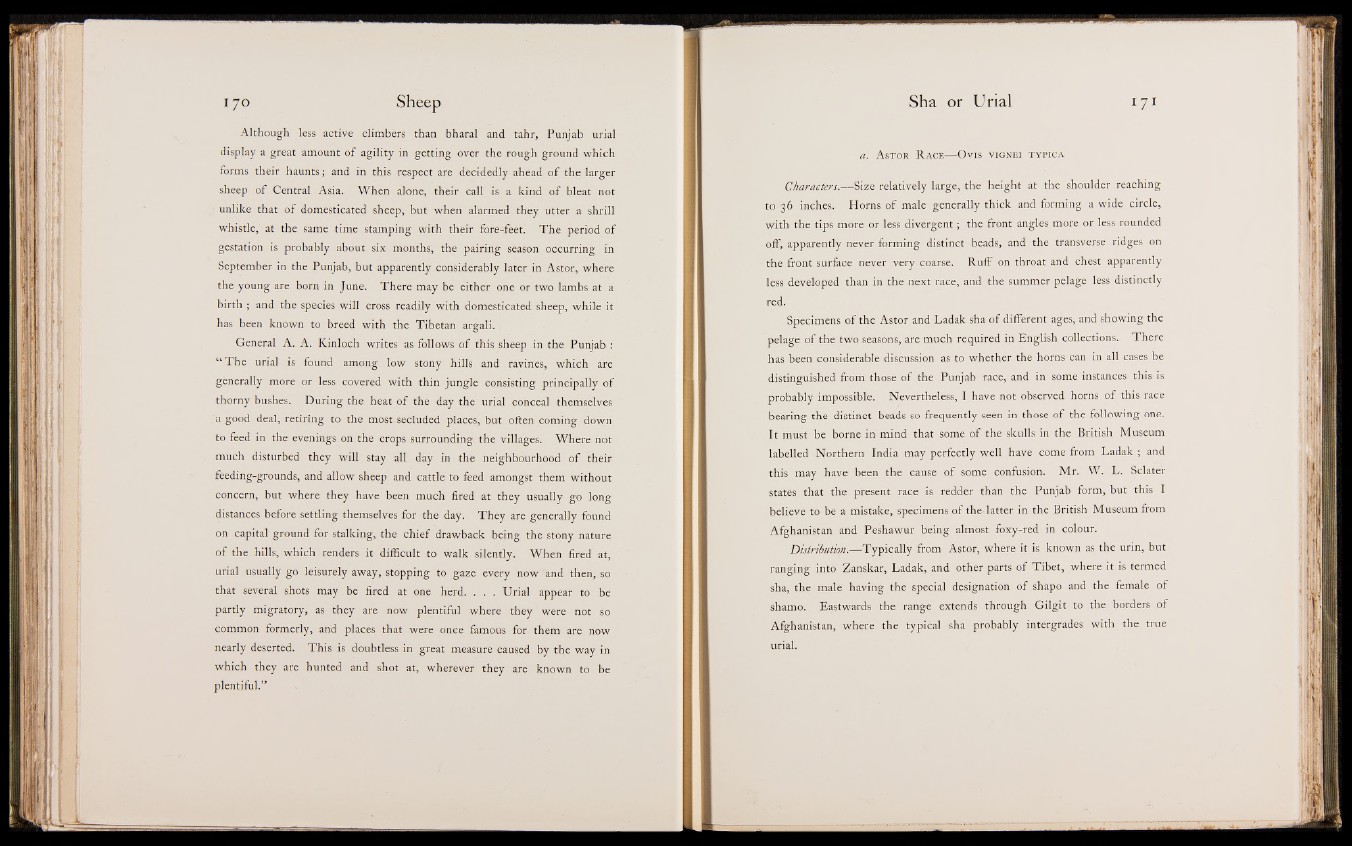
Although less active climbers than bharal and tahr, Punjab urial
display a great amount of agility in getting over the rough ground which
forms their haunts; and in this respect are decidedly ahead of the larger
sheep of Central Asia. When alone, their call is a kind of bleat not
unlike that of domesticated sheep, but when alarmed they utter a shrill
whistle,' at the same time stamping with their fore-feet. The pe(|bd of
gestation is probably about six months, the pairing seasorljbccurring . in
September in the Punjab, but apparently-considerably later in Astor, where
the young are born in June. There may be either one or two lambs at a
birth ; and the species will cross readily with domesticated sheep, while it
has been known to breed with the Tibetan argali.
General A. A. Kinloch writes as follows of this, sheep in- the Punjab :
“ The urial is found among low stony hills and ravines, which are
generally more or less covered with thin jungle consisting principally of
thorny bushes. During the heat of the day the urial conceal themselves
a good deal, retiring to the most-secluded places, but . often coming down
to feed in the evenings on the crops surrounding the villages. Where not
much disturbed they will stay all day in the neighbourhood of their
feeding-grounds, and allow sheep and cattle to feed amongst them without
concern, but where they have been much fired at they usually go long
distances before settling themselves for the day. They are generally fipund
on capital ground for stalking, the chief drawback being the stony nature
of the hills, which renders it difficult to walk silently. When fireef at,
urial usually go leisurely away, stopping to gaze every now and then, so
that several shots may be fired at one herd. . . . Urial appear to be
partly migratory, as they are now plentiful where they were not so
common formerly, and places that were once famous for them are now
nearly deserted. This is doubtless in great measure caused by the way in
which they are hunted and shot at, wherever they are known to be
plentiful.”
a . A sto r R a < |§ SO v i s v ig n e i t y p i c a
CharactersWSmze relatively large, the height at the shoulder reaching
to 36 inches. 11 orris of male generally thick and forming a wide circle,
with the tips moft^BleHdivergent; the front angles more or less rounded
off, apparently never forming distinct beads, and the transverse ridges, on
the front surface never very course. Ruff on throat and chest apparently
ld§J developed than in the next race, and the summer pelage less distinctly
red.
"Specimens of the Astor and Ladak sha of different: ages, and showing the
pelage of* the two seasons, are much required in English collectiJi|||j; There
has been considerable discussion as tssjwhether the horns can in all eases be
distinguished from those of the Punjab race, and in some instances this is
probably impossible. Nevertheless, I have not observed horns of this race
bearing the distinct beads so frequently seen in those of the following one.
It must be borne in mind thatRme of the skulls in the British Museum
Babelled Northern India may perfectly well have come from Ladak ; and
this may have been the cause dB some confusion. Mr. W. L. Sclater
states that the present race is redder than thgjPunjab form, but this I
believe to be a mistake, specimens of the-latter in the British Museum from
Afghanistan and Peshawur being almost foxy-red in efijour.
Dzffr&fczftijw.gTypically from AinH where it is Known as the urin, but
ranging into Zanskar, Ladak, and other parts; f f Tibet, where it is termed
sha, the male having the special designation* shapo and the female of
shamo. Eastwards the range extends through Gilgit to the borders of
Afghanistan, where the typical sha probably intergrades with the true
urial.